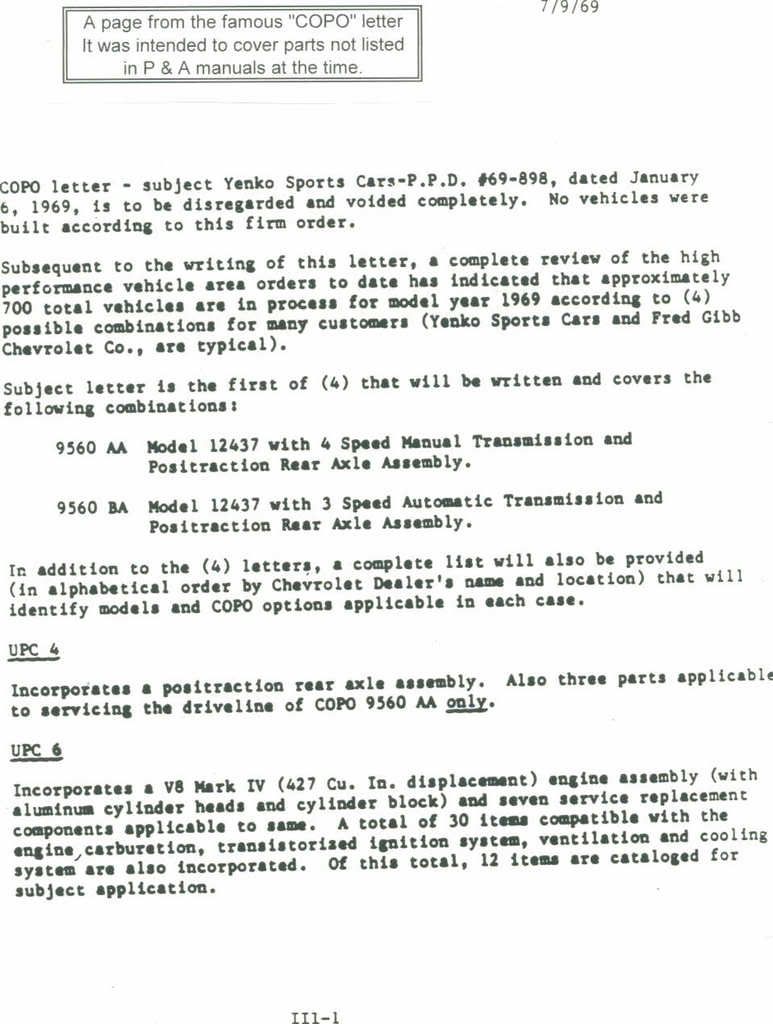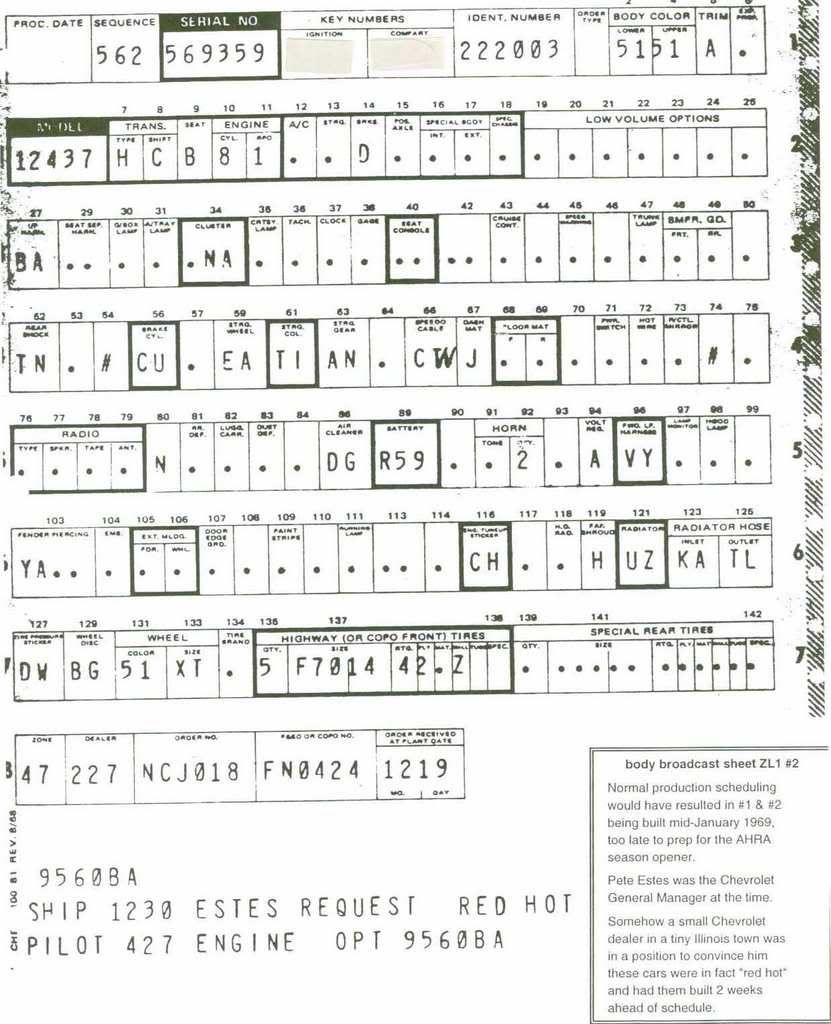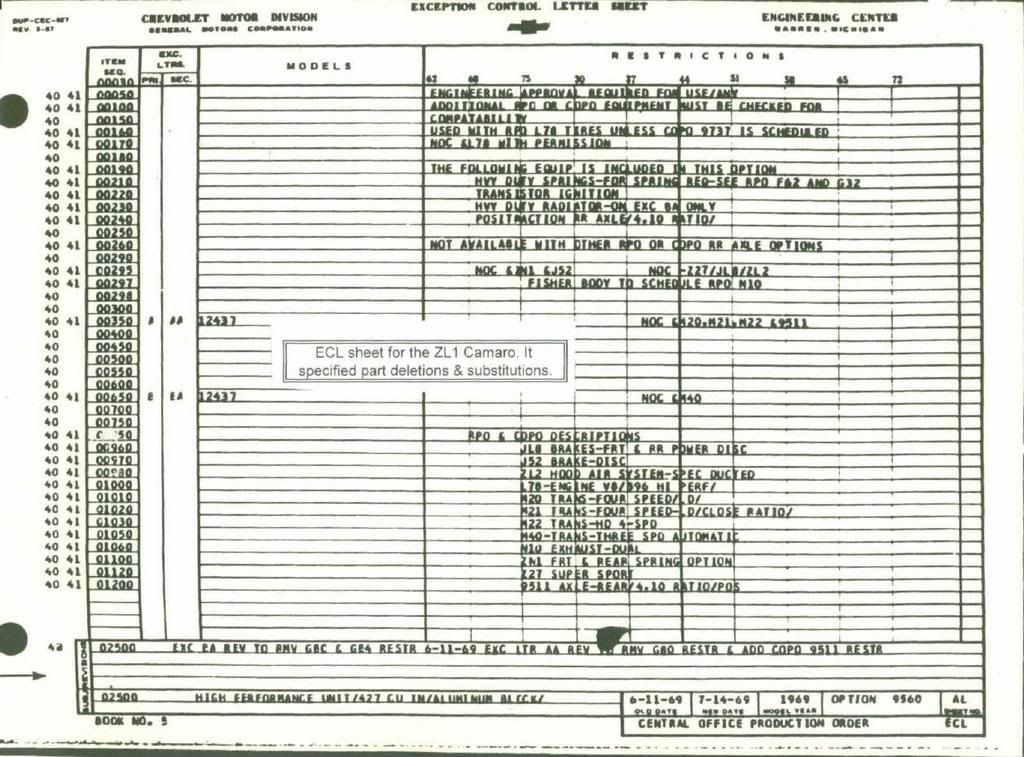|
AF Regular
Join Date: Jul 2007
Location: Lake Superior, Michigan
Posts: 172
Thanks: 0
Thanked 3 Times in 3 Posts
|
Re: Copo
Here is some more info I have..Prior to 1969 model year, Yenko and a few others did transplant engines. They were order L78 and remove them, transplant in a 427, add Yenko badging and sell them as is, no warranty. But somehow they were able to convince Chevy they were losing races because Chevy was not building cars.
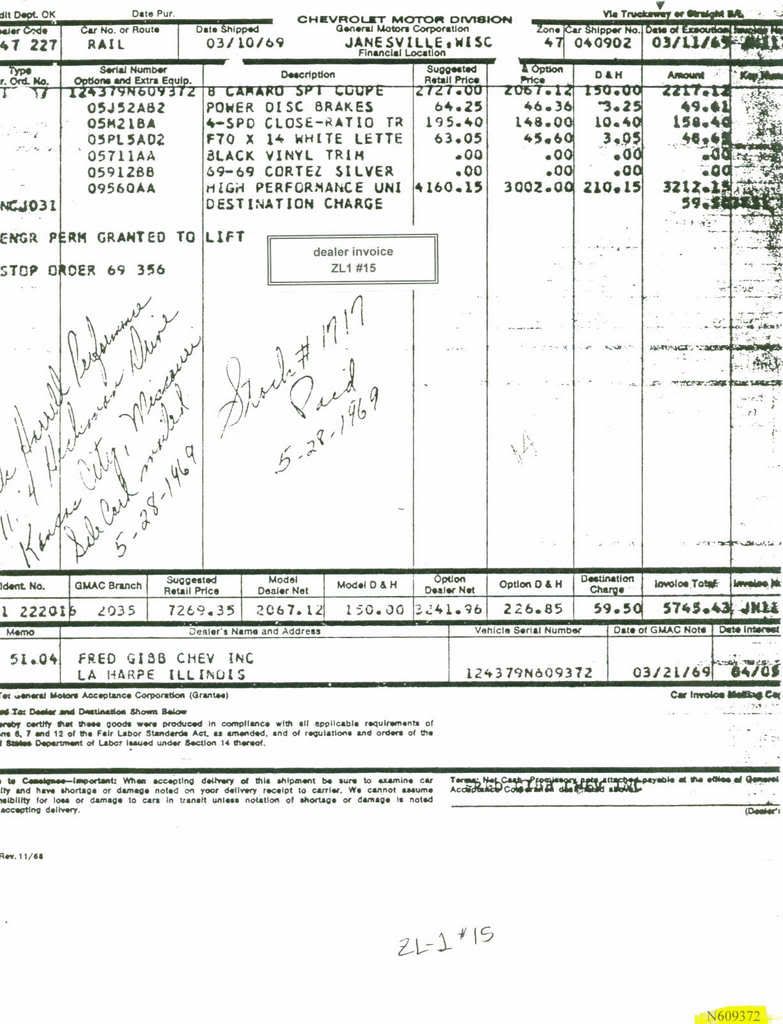
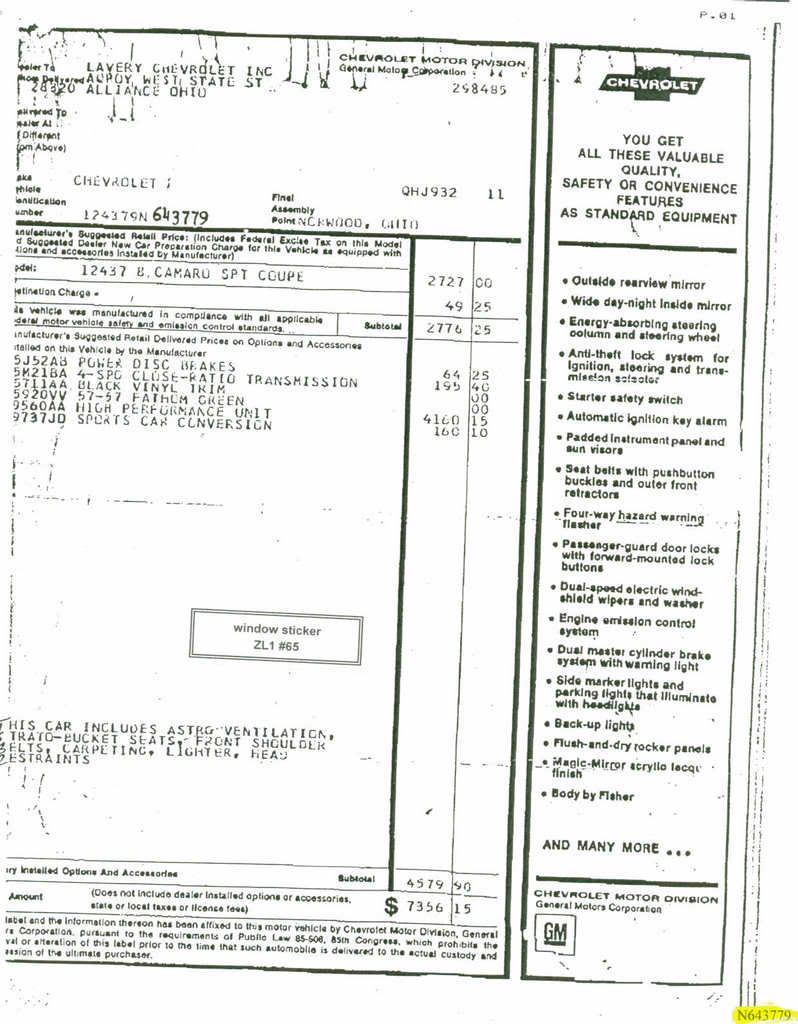
Quote:
By 1969, the Chevelle Super Sport no longer stood alone as a separate model, but rather was a 396 engine and trim package added to a Malibu, 300 Deluxe Malibu or El Camino. Furthermore, 1969 is the only year an SS package could be ordered on the base-model 300 Deluxe.
Chevrolet also offered some incredibly strong engine packages by 1969, including the largest displacement engine available since the Chevelle's introduction: the L72 427-cu.in., 425hp engine. However, few knew about this rare option.
In 1969, others, particularly Chrysler, were offering large-displacement engines with multiple carburetors and, for a variety of reasons, GM had to keep up. While Chevrolet offered tri-power options on the Corvette, the Chevelle SS was relegated to a single four-barrel carburetor. While Chrysler offered the 440 Six Pack and 440 Six Barrel, the cars with these engines usually wore badging and hoods with mailbox-like scoops-hardly what you'd describe as stealthy.
In stark contrast to the extroverted approach at Chrysler, Chevrolet inserted tire-melting big-block power in stripped Chevelles that savvy buyers knew were available only as Central Office Production Orders.
It is believed that Don Yenko was behind the inception of this COPO option, allowing his SYC promotion of the hot S/C Chevelles without the need for the time-consuming and expensive engine swaps. Yenko took a COPO car and added distinctive custom side and hood striping, along with 427 and crest emblems.
Chevrolet built 86,307 SS Chevelles in 1969, and of that number, 323 were COPO cars. Of those elite 323, 99 were sent to Yenko to be transformed into a Yenko S/C Chevelle at his Canonsburg, Pennsylvania, dealership.
Yenko had hopes of keeping this now-infamous loophole a secret that only he could take advantage of. But that secret didn't last long. Berger Chevrolet began ordering Camaros and Chevelles for their own purposes, and so did several other dealerships-some of which just sold off the cars unmolested to their customers. Chevrolet's ordering guidelines specified that any and all COPO cars built had to be available to any Chevrolet dealer, and it is known that 17 COPO cars were sent to Canada.
So powerful were these Chevelles, they could, in stock trim, cover the quarter mile in 13.3 seconds at 108 mph. The COPO Chevelle could be ordered in a number of different COPO combinations, depending on several factors.
Basically, ordering COPO 9562 or 9566 deleted the L78, a 396-cu.in. 375hp engine and added the L72 427. The Harrison three-core radiator and dual exhaust also were part of the COPO option. RPO NC8 chambered exhaust was an available option and equipped on a limited number of Chevelles.
According to Ed Cunneen of COPO Connection, the recognized authority on these special cars, there is no obvious identification of COPO cars on the VIN or the trim tag. The only concrete identifier of a COPO car is one of the six-digit option codes listed below, which appears only on the car's build sheet and the original window sticker. Luckily, most GM cars have build sheets hidden in the cars, but of course, it's easier to fake one than it is to fake a VIN plate or a trim tag, so buyer beware.
All COPO cars carry one of the option codes below:
9562AA: Four-speed transmission and positraction
9562BA: M40 three-speed automatic transmission and positraction
9562cd: Four-speed manual, special contour bucket seats, COPO tires and special-order springs
9562ce: Same as above, excludes bucket seats
9562dd: M40 automatic, bucket seats, COPO tires and special springs
9562de: Same as above, minus bucket seats
9562ea: Four-speed manual transmission, positraction, J52 disc brakes and L78 tires
9562fa: Same as above, except M40 automatic replaced four-speed
9566aa: Same as 9562EA with the exception of tires (used RPO PL5 14s)
9566ba: Same as 9562FA with the exception of tires (used RPO Pl5 14s)
9694ca: Four-speed together with 9562, 9737 and RPO J50 vacuum power brakes (This option modified RPO J52 power brakes)
9694cb: Three-speed automatic transmission together with 9562DD, 9737LD and RPO J50 vacuum power brakes (This option modified RPO J52 power disc brakes)
9737ld: Sports car Conversion/ Yenko/ This option was 15-inch tires and Rally wheels
According to Cunneen, it appears that only the 9566 options would have been used on non-Yenko orders. Yenko orders would have carried 9562, 9694 and 9737 codes.
No matter what package you ordered, all of these cars included a special heavy-duty rear axle with special heat-treated 4.10:1 gears. Records show GM built 96 COPO Chevelles with automatic transmission (Code MP) and 277 with a four-speed (Code MQ).
Given that most of these cars have been accounted for, there is a vast amount of knowledge on their history that can be derived from sources like COPO Connection. Cunneen runs an excellent web site (www.copo.com), with more history and information than we could possibly cover in these few pages.
If you're truly interested in buying one of these cars, or have stumbled across one that you think may be a COPO car, the following pages will be a starting point, but be sure to follow up with additional information from other sources.
Engine
No matter what the ordering code, all COPO Chevelles were powered by the 425hp L72 V-8, which stands among the most powerful engines ever put in a production Chevrolet passenger car. GM records show 373 of these engines were built at the Tonawanda assembly plant in New York, but this number reflects only engines built, not total number of cars made. Taken right from the Corvette, the COPO Chevelle had 425hp from the cast-iron big-block with cast-iron heads, which were stuffed with giant valves, 2.19-inch intakes and 1.72-inch exhausts, 11.1 compression, a 0.520-lift solid-lifter camshaft and a 780cfm Holley atop an aluminum intake manifold. All engines had an open-element air cleaner with a chrome lid and chrome rocker arm covers. Even with a power-robbing air injector reactor pump, these cars were quite formidable. The 427 Chevrolet engine is easily rebuildable, and every part needed to put one back to stock configuration or elevate to all-out race form is available. The engine codes were MP for the automatics and MQ if equipped with a manual transmission.
Transmissions
Transmissions available with a COPO Chevelle were the M20, M21 and M22 "Rock Crusher" Muncie four-speed manual transmissions. Also available was a special Turbo Hydra-Matic 400. All had legendary strength, and parts to overhaul any of these transmissions are readily available, even though Muncie parts are getting expensive. The internally upgraded "CX" Turbo Hydra-Matic is known as the strongest automatic ever from GM and came with a heavy-duty six-bolt torque converter. According to Cunneen, a special speedo-reducer came with all four transmissions in order to calibrate the correct speedometer reading.
Differentials
The 12-bolt rear axle has anvil-like durability and is among the strongest ever to make it into a passenger car; to withstand 460-lbs.ft. of torque, it had to be. The only rear axle available came with a 4.10:1 ratio with a special heat-treated ring gear. This rear differential included a special heavy-duty Positraction case with unique parts not interchangeable with other 12-bolt cases. The code for a COPO Chevelle is KQ.
Suspension & Brakes
The independent front suspension used the same setup Chevrolet had for many years: short/long A-arms, coil springs, ball joints and hydraulic shock absorbers. The rear utilized a linked Salisbury axle, boxed control arms, coil springs and hydraulic shock absorbers. The standard braking system consisted of four-wheel drum brakes with 9.5-inch-diameter drums. If disc brakes were ordered, the cast-iron, vented rotors measured 11 inches and were 1-inch thick. COPO Chevelles did not receive the special F41 suspension option that made it to so many other SS Chevelles.
Wheels & Tires
COPO 9737 was available with COPO Chevelles, and was included on all Yenko Chevelles. This option specified F70x15-inch Goodyear Wide Tread GT tires on 7-inch Rally wheels (Code YH). These special tires were reportedly never used on any other Chevrolet. The remaining COPO Chevelles received F70x14-inch tires on 7-inch Super Sport wheels (Code YA), which included the SS emblem in the center cap.
Chassis
The Chevelles used a strong, welded, full-perimeter frame, widely spaced behind the front wheels. The wheelbase stood at 112 inches while the car's overall length was 197.5 inches. Like all Chevelles, COPO cars are somewhat susceptible to rust, but under normal, non-winter driving conditions, the frames last a long time. They should be checked for accident damage as many of these cars were driven hard throughout the years. Rust is particularly insidious in front of the kickup that rises up and over the rear axle, and frames have also shown stress cracks in the same location. If buying a car in a northern climate, carefully inspect the portions up over the rear axle for rust and or signs of repair. Good frames can be found, but are getting tougher to locate every day.
Body
Rust is the biggest problem facing the beautiful A-body cars of this generation. The rear window treatment was particularly eye-catching, with over 1,000 square inches of glass. But that big rear opening is exactly where the trouble starts.
Factory primer was never applied inside the pinchweld, where the glass recessed into the body. Once water got in behind the moldings, the results were predictable and tragic. Pinchwelds in both the front and rear windows can rot completely out, allowing water to drip behind the dashboard and into the trunk. In turn, trunk mats and carpets got wet, allowing the floor pans to rust. Beyond that, lower quarter panels, wheel lips and rocker panels were particularly prone to rust. The bodies were painted with acrylic lacquer in those days with no clearcoat. A 1969 COPO Chevelle has some SS features, like the twin-domed hood, blackout grille and blackout panel between the taillamps. A blue Chevrolet Bowtie emblem replaced the SS badge in the center of the grille. The D96 upper body accent stripe could be ordered.
Interior
Here's where identifying a real COPO car gets tricky. Not all COPO Chevelles came with an SS badge on the steering wheel. Most came with a blue bowtie emblem. The door panels say Malibu, not SS, and there were very few cars built with the tachometer and gauge package, which was optional. If a COPO Chevelle had an optional tachometer, the redline will read 6,000 rpm. A bench seat came standard and buckets were available. The standard and only door panel is a one-piece vinyl item with armrest and chrome door release handle.
Reproduction Parts
Since the COPO package is essentially a driveline option, almost every part needed to restore these cars is available from hundreds of outlets. Even a brand new, correct style Holley carburetor can be bought. Correct rocker-arm covers, exhaust manifolds and air cleaners are being reproduced. Parts suppliers such as Ground Up Restorations offer a nearly unlimited catalog of restoration pieces, from door latches to fuel tank sending units, to OEM nuts and bolts. There was a time when, if the console was missing, you had to trudge through a junkyard and hope to find a decent used console that invariably had broken or missing parts. Those days are over. Complete reproductions are coming to market soon from Original Parts Group in California. Dash pads can be bought for as little at $160 and hundreds of other items also are available from carpet to wiring harnesses.
Performance Parts
After the Chevrolet small-block, this engine probably enjoys a stronger aftermarket than any other American muscle car engine. Whatever you call it, big-block or rat, there are numerous vendors in Hemmings Motor News with everything you need to upgrade the performance of your 427 engine. One can find complete engine rebuilding kits, aluminum cylinder heads and even digital fuel injection from Holley. This fuel-injection kit includes everything needed including in-line electric fuel pump and wiring harness for about $1,400. Extra-large oil pans can be installed and, of course, there is an array of headers and aftermarket exhaust systems to really wake up that 427. There are also aftermarket disc brake upgrade kits available to install four-wheel disc brakes.
Chassis Upgrades
This is the single biggest improvement one can make to an A-body car from this era. Beefier anti-roll bars and polyurethane bushings can greatly improve handling. Switching to 50- or 60-series rubber is a simple upgrade and makes an A-body come alive because the higher sidewalls on the original 70 series tires tend to flex more. The simplest, least intrusive and most authentic change is to ensure your car's tires have the proper air pressure.
The original shock absorbers leave a lot to be desired, so adding a set of gas shocks is a good idea and can be done in an afternoon in your driveway. Polyeurethane bushings will help make the chassis more responsive though they don't absorb road shocks as well as softer OEM parts. Suppliers such as Performance Suspension Technology in New Jersey and Global West in California offer every imaginable chassis upgrade to make your Chevelle a serious handler.
Owner's View
Peter Simpson, 43, is not afraid to flog this extremely valuable car he found in Hemmings Motor News in 1987. "The owner could not sell it, as he was asking a lot of money. I bought it and it is now worth many times what I paid, but that's not why I bought it. I drive this car and have raced it. It runs in the mid 12s with exhaust manifolds and drag radials," Simpson said. "The car was bought at Central Chevrolet here in Ontario and they were the high-performance Chevy dealer in Canada. They used to order COPO cars and sold them right off the lot."
Asked why he selected this car over many others, Simpson responded: "I've always liked Chevrolets. I own four COPO cars and this is my favorite. I can wind it up to 7,000 rpm and I've never had any trouble with it. I love the Daytona Yellow paint. It is loud and proud. Of all my cars, this is my favorite. It rides like a Cadillac and is very fast."
Values
1969 COPO Chevelle
Low Average High
$20,000 $32,000 $60,000
Parts Prices
Bell housing, used $200
Bumper, front, reproduction $160
Bumper, rear, reproduction $160
Dash pad, replacement $160
Door hinge bolt kit $23
Fan shroud, reproduction $65
Fan, 7-blade $125
Front armrest pads, repro. $20
Lower control arm, repro. $150/ea
Mufflers, chambered, repro. $300
Oil pan, GM, new $200
Radiator, OEM replacement $495
Seat cover, bench front, repro. $215
Spiral shock, NOS $100
Spiral shock, correct repro. $60
Steering wheel, 3-spoke, repro. $200
Trunk spatter paint, black/aqua $55/qt
|
__________________
Mike
2010 GMC Sierra SLT E. Cab Z71 All Terrain
2009 Cadillac CTS4 3.6L AWD Performance Sedan
|



 Show Printable Version |
Show Printable Version |  Email this Page |
Email this Page |  Subscribe to this Thread
Subscribe to this Thread


















